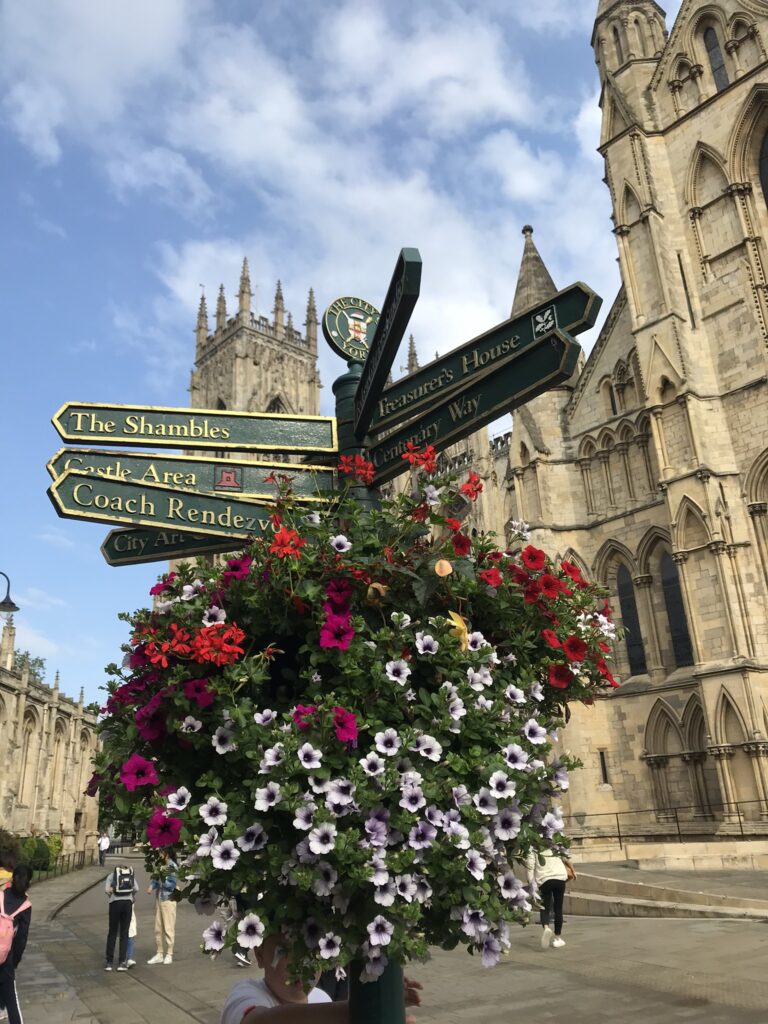York is an ancient city dating back to AD 71 when the Romans landed, so we are surrounded by history and thankfully our visitors to York can get a good sense of its past when strolling around the streets.
Join me as we discover a city where we can walk through history via our many eateries.
We can have breakfast with a Norman at Gray’s Court, morning coffee with a Victorian on Lendal Bridge in one of two former toll booths or at Starbucks on Coney Street, or with a Roman at the Roman Bath pub. Lunch with a Georgian at the Assembly Rooms, take Afternoon tea with the Flappers at Bettys, or toast the adventure with an afternoon beer with the Vikings at Valhalla! Then, an evening out with the Edwardians, pre-dinner drinks at the Cosy Club followed by dinner at the Grand Hotel. Sadly we can’t have anything with a Saxon – they only built things in wood so nothing survived!
Let’s celebrate the re-purposing of buildings and consider their place in our history.
Roman – The Roman Bath Pub in St Sampson’s Square was built above an ancient Roman bath house. Its remains were uncovered when this pub was built replacing the Mail Coach Inn. They discovered the Caldarium or ‘hot room’ dating back to Roman York in AD 71. So we’re cheating a little and calling it Roman but really it was built in the 1930s!
Viking – Valhalla York in Patrick Pool is a Viking theme bar. Valhalla means the hall of the slain, where you go if you die in combat.
Norman – Grays Court Inn in Chapter House Street is a lovely hotel. Its interior dates back to Norman times. It is the oldest continually inhabited house in Britain, dating back to the 11th century. It looks Georgian on the outside but its core inside is Norman.
Medieval – Gatehouse Coffee inWalmgate Bar is a café housed in the actual bar/gatehouse, a unique setting in the walls of the city, originally constructed in medieval times.
Tudor – Gert and Henrys Restaurant in Jubbergate – dates back to the 1600s and is housed in an old Tudor building. The building now belongs to York Conservation Trust.
Georgian – Ask Italian in Blake Street – the old Assembly Rooms. In the 1700s York needed something grander to hold its assemblies in for dancing and card games, sometimes held at Kings Manor. The Assembly Rooms were built, styled on an ancient Egyptian Hall designed for festivals and entertainment with a theatrical interior including Corinthian columns and bays.
Victorian – Quirky Cafe and Sophie on Lendal Bridge. These cafes were both toll houses for the bridge. There was a charge of half a penny for foot passengers, a penny for animals and twopence for horse-drawn vehicles.
Pizza Express housed in River House in Museum Street. Built in 1869 for a gentlemen’s club. The Yorkshire Club founded in 1839 with original premises at St Leonard’s Place. All the Yorkshire aristocratic gentlemen were members. No ladies allowed, they could only go as guests occasionally!
Starbucks Coffee in Coney Street was formerly a National Westminster Bank, there is a sign above the main door. The crest on the building is the Becket Coat of Arms and the inscription means “to do good to one’s fellow man”.
Edwardian – The Grand Hotel on Station Rise was originally built in 1906 as the Headquarters of the North Eastern Railway Company (NERC) and it was regarded as a ‘Palace of Business’ when it was built, NERC was then one of richest businesses in Britain. It has now been restored as a luxury 5 star hotel.
The Cosy Club in Fossgatestarted life as Yorks first purpose-built movie house, the Electric Cinema in 1911.
Art Nouveau – Bettys in St Helen’ Square. Frederik Belmont opened Bettys in 1919 in Harrogate. It opened in York in 1937, modelled on the Queen Mary, the ocean going liner, after he sailed on its maiden voyage. Craftsman from there came to York and turned this furniture storeroom into an elegant tea room.
Enjoy the historical feast!
Article contributed by Linda Metcalfe – https://yorkshiresbestguides.co.uk/project/linda-metcalfe/





